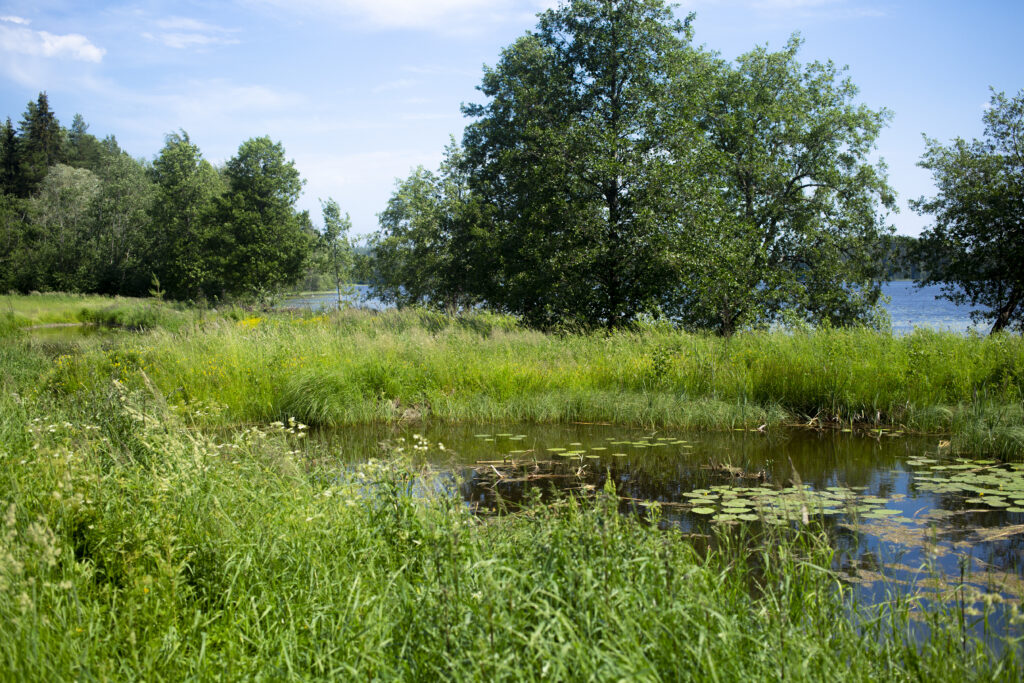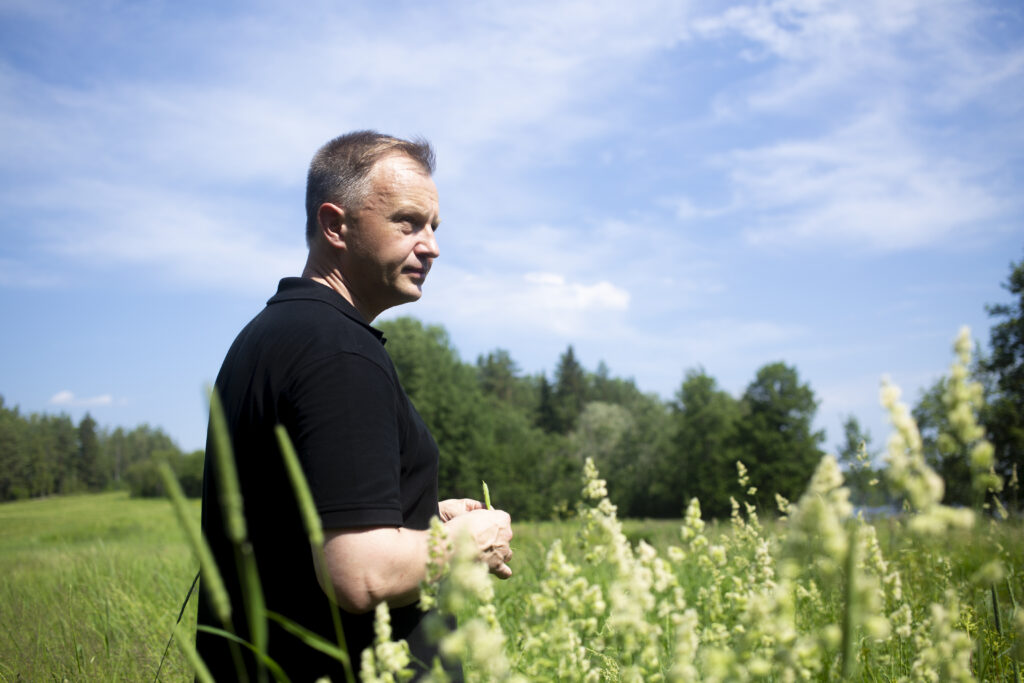Situated alongside Lake Vesijärvi, in the midst of lush forests and ancient hunting grounds once accessed via waterways, Lisko Farm has a well-established tradition of producing crops with great respect for the surrounding environment.

When Sauli Brander took over the farm from the previous generation in 2005, a number of protective measures were already in practice. The first wetlands were constructed in the 1990s to treat surface water. Settling ponds and protective strips were in place, and a minimum tillage system was being followed. All measures that Sauli and his family were happy to carry forward.
Managing surface water on sloping fields
Given the sloped nature of the fields on Lisko Farm, as well as the farm’s close proximity to the lake, preventing nutrient run-off requires an ongoing effort. Despite progress that had already been made, after taking over the farm Sauli found that there was still more to be done. One particular indicator of this was the nearby lake.

“Our summer cabin is located by the lake shore,” explains Sauli. “Water clarity was poor and there was a lot of primary production in the lake. Also, green-blue algae could be seen every now and then. Since the 1980s, the condition of the lake has gotten worse.”
Sauli and his family were motivated to continue making progress and wanted to do their part in tackling the problem.
“After the first catchment pond was built and the visual effects were seen, we wanted to continue sustainable practices so we could leave the lake and field in even better condition for the next generations,” says Sauli.
In addition to maintaining the existing wetlands and catchment ponds, to address the problem, Sauli and his family have established buffer zones between the fields and the lake and have taken action to ensure that all surface waters that drain from the fields and main ditches close to the farm’s centre are run through wetlands and sediment basins before entering the lake.
After the first catchment pond was built and the visual effects were seen, we wanted to continue sustainable practices so we could leave the lake and field in even better condition for the next generations.
To help keep nutrients on the field, the farmers plant intercrops and maintain year-round plant cover. They also practice reduced tillage, mainly in the springtime, to reduce the amount of soil leaving the fields. The fields with peat soil are kept as either permanent grasslands or nature management fields.
Careful fertilization and nutrient cycling
Certified organic since 2010, no chemical fertilizers are used on Lisko Farm. Sauli and his family are careful to only fertilize with the necessary amount of nutrients every year.
Fertilization is based on soil fertility analyses and nutrient balances are used to continuously evaluate the use of nutrients. Green manure, broiler and chicken manure, and meat and bone meal are used as fertilizers and are applied to the fields in the spring and early summer when plants can use the nutrients most efficiently. The farmers also take care to ensure that manure is spread evenly using a field navigator.

Certified forestry and climate action
Biodiversity and climate action are also a priority on Lisko Farm. Although animal husbandry hasn’t been practiced on the land since 1983, the farmers have managed to maintain the biodiversity of the traditional biotopes.
A total of 370 hectares of FSC certified forestland are maintained on the farm. Fifteen hectares are permanent outside of forestry and another 15 hectares are dedicated as development areas for biodiversity. The farmers are also conserving about five hectares as part of their participation in METSO, a forest biodiversity programme for Southern Finland.
Many of our co-farmers have asked us questions about best practices when switching to organic farming.
Sauli and his family also take action for the climate and have a high degree of energy self-sufficiency through their use of solar energy and biomass for the farm’s heat and electricity needs. About 70% of the farm’s electricity comes from solar energy (about 15.5 kWp). All the buildings on the farm are heated with wood chips made from willows and other wood collected from the field edges and ditches each year.
Sharing their knowledge with other farmers
As a result of all their efforts to prevent nutrient run-off and run their farm more sustainably, Sauli and his family have reported a visual improvement in soil structure and fertility. Results that have been noticed by neighboring farmers too.
“Many of our co-farmers have asked us questions about best practices when switching to organic farming,” says Sauli.
Sauli and his family gladly share what they have learned. They pass along their best practices by holding presentations at the farm every year, and continue to participate in organic field events to exchange learnings with other farmers.
Grand Prize Regional winner of the Baltic Sea Farmer of the Year Award 2021
In recognition of the efforts made on Lisko Farm to reduce nutrient run-off, Sauli has been awarded with the Grand Prize Regional Baltic Sea Farmer of the Year Award.
“Of course, I am pleased to have this honor, but nothing special has been invented on the farm,” says Sauli. “We’ve studied the latest research and other farmers’ practical experiments and implemented those best practices on our farm.”
As for future plans, Sauli says they are looking forward to developing the farm further with a focus on enhancing diversity and improving self-sufficiency and economics.
What advice do you have for other farmers?
“Every farm has a unique location. Farmers should seek out best practices that fit their fields and environments. By listening to others, you can improve your own understanding of best practices and pick up the most important ones.”
In 2019, Holger van der Woude received the national Baltic Sea Farmer of the Year Award in recognition of his efforts to reduce nutrient runoff on his farm.
FARM FACTS
Location: Suinula, Palonkylä, Kangasala, River Kokemäenjoki catchment area, Finland
Type of farm: Organic crop farm (194 ha)
Main production: Oats, rye, peas, and grass
Key practices: Year-round plant cover, protecting soil structure from compaction, catch crops, enriching soil with organic matter, buffer zones, constructed wetlands and catchment ponds, water management, nutrient balance and balanced fertilization, correct timing and conditions for fertilizer application, careful manure application techniques, use of manure in plant production, precision farming, nutrient recycling.
Jury motivation: “Lisko Farm has practiced environmentally friendly farming methods for a long period of time which was considered as a clear benefit for the farm. For example, wetlands that treat the surface waters in the farm were constructed already in the beginning of the 1990s and intercrops have been tested before catch crops were included in the agri-environmental scheme. Intercrops that grow through winter to the next spring are grown together with cereal and peas in all the parcels. Tillage mainly takes place in the spring and the farm practices reduced tillage. Long-term plant cover and a short period between tillage and sowing protects the soil from erosion and keeps nutrients circulated. Catch crops and reduced tillage are an excellent combination in soil management.” (Read more)

OPINION
Sauli Brander on the future of farming
Q: What do you consider to be the biggest challenges or threats facing farmers today and in the future?
A: Economic results.
Q: What are the greatest benefits/opportunities in farming today and in the future?
A: By farming, we can prevent climate change and produce pure food for people.
Q: What kind of support and encouragement do farmers in your region need to adopt and maintain more sustainable practices?
A: More research is needed for climate positive cultivation and financial support is needed for investments. Support is also needed to facilitate knowledge exchange between farmers, and between farmers and the agricultural industry.

